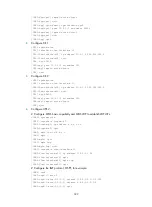
314
# Configure PE 1 and inject IS-IS routes.
[PE1] ip vpn-instance vpn1
[PE1-vpn-instance-vpn1] route-distinguisher 200:1
[PE1-vpn-instance-vpn1] vpn-target 1:1
[PE1-vpn-instance-vpn1] quit
[PE1] mpls ldp vpn-instance vpn1
[PE1-mpls-ldp-vpn-instance-vpn1] quit
[PE1] isis 2 vpn-instance vpn1
[PE1-isis-2] network-entity 10.0000.0000.0000.0003.00
[PE1-isis-2] import-route bgp allow-ibgp
[PE1-isis-2] quit
[PE1] interface vlan-interface 11
[PE1-Vlan-interface11] ip binding vpn-instance vpn1
[PE1-Vlan-interface11] ip address 11.1.1.2 24
[PE1-Vlan-interface11] isis enable 2
[PE1-Vlan-interface11] mpls
[PE1-Vlan-interface11] mpls ldp
[PE1-Vlan-interface11] mpls ldp transport-address interface
[PE1-Vlan-interface11] quit
[PE1] bgp 100
[PE1-bgp] ipv4-family vpn-instance vpn1
[PE1-bgp-vpn1] import isis 2
[PE1-bgp-vpn1] quit
[PE1-bgp] quit
# Configure CE 1.
[CE1] interface vlan-interface 11
[CE1-Vlan-interface11] ip address 11.1.1.1 24
[CE1-Vlan-interface11] isis enable 2
[CE1-Vlan-interface11] mpls
[CE1-Vlan-interface11] mpls ldp
[CE1-Vlan-interface11] mpls ldp transport-address interface
[CE1-Vlan-interface11] quit
After the configurations, PE 1 and CE 1 can establish the LDP session and IS-IS neighbor
relationship between them.
# Configure PE 2 and CE 2 in a similar way as you configure PE 1 and CE 1. (Details not shown.)
4.
Perform configuration to connect the CEs of the end customers to the PEs of the customer carrier:
# Configure CE 3.
<CE3> system-view
[CE3] interface vlan-interface 11
[CE3-Vlan-interface11] ip address 100.1.1.1 24
[CE3-Vlan-interface11] quit
[CE3] bgp 65410
[CE3-bgp] peer 100.1.1.2 as-number 100
[CE3-bgp] import-route direct
[CE3-bgp] quit
# Configure PE 3.
[PE3] ip vpn-instance vpn1
















































